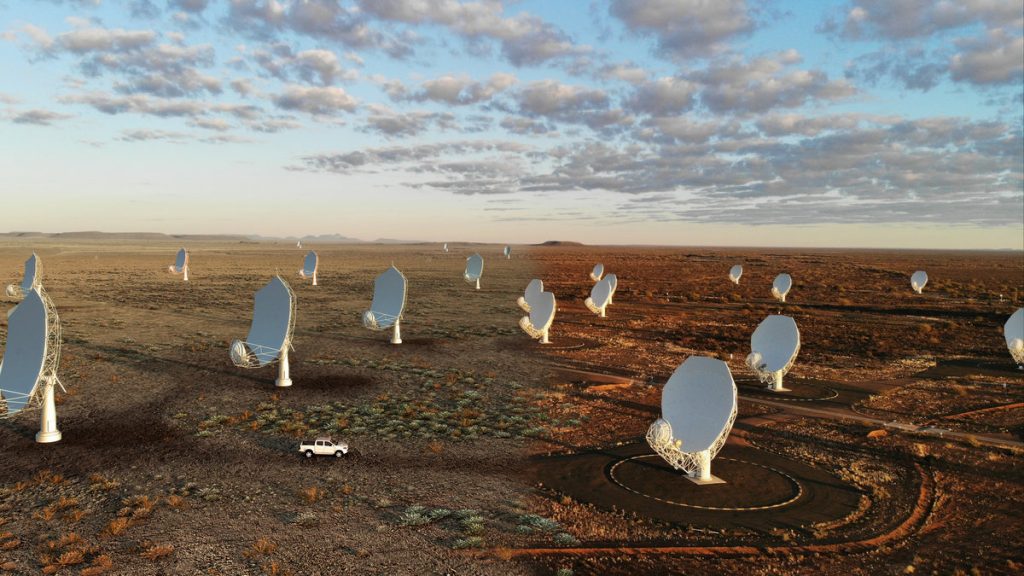Astronomers simulate physical processes in the interstellar medium of galaxies at ‘cosmic noon’ for future SKAO observations
An international team of researchers has demonstrated that the Square Kilometer Array Observatory (SKAO) is capable of detecting radio emissions from regular spiral galaxies in the early universe. SKAO, whose construction began this year, will soon become the world’s largest radio telescope. Astronomers, part of the Successive Extragalactic Working Group, are looking for a way to explore a cosmic era in which star-forming activity abruptly declined after an era known as the “cosmic noon.” To do this, they simulated the physical properties of interstellar interstellar galaxies similar to the Triangle (M 33) and Whirlpool (M 51) galaxies in the early age of the universe. The results suggest that potential surveys should be sensitive enough to detect galaxies as early as SKAO’s initial construction stage.
© SKAO
Composite image of the future SKA-Mid telescope, showing those already in place
The antennas of the former MeerKAT telescope with an artist’s rendering of future SKA-Mid telescopes.
In the course of cosmic evolution, after a more active period about 10 billion years ago, the so-called “cosmic noon”, galaxies experienced a decrease in the activity of star formation. The transition from the golden age of star formation to a slower rate of star formation is still not fully understood. A decrease in the amount of cold gas in galaxies, which fuels star formation, is often thought to be the main cause. Observations show, however, that many galaxies still have gas reserves large enough to support star formation.
“Another possibility is that the pressure from magnetic fields, high-energy particles, and turbulence increasingly stabilized cold gas in galaxies,” says Fatima Tabatabai. She is a former researcher at the Max Planck Institute for Astronomy (MPIA) in Heidelberg and co-author of the study. She is now a faculty member at the Institute of Research in Basic Sciences (IPM) in Tehran, Iran. “To understand the importance of these factors, studies of energy balance as a function of redshift are required,” she continues.
Phenomenon spectra, for example b- emitted by galaxies are shifted to longer wavelengths over time due to the expansion of the universe. The redshift can be directly converted into distance or age since the Big Bang.
To assess whether the future Square Kilometer Array Observatory (SKAO) could help solve this mystery, astronomers simulated the physical processes in the interstellar medium (ISM) of galaxies at different redshifts. ISM is composed mostly of gas and microscopic particles, which astronomers call dust, of varying temperatures that permeate interstellar space. The first part of this research paper was published today in the journal Monthly Notices of the Royal Astronomical Society chest.
Radio broadcast monitoring is a powerful tool for following active processes in galaxies. This emission is mainly due to the interaction of high-energy particles with magnetic fields, which is an active component of the ISM. Deep, spatially resolved observations at different radio frequencies using SKAO allow astronomers to map these processes in near and far galaxies. “Observations like this are a critical step in understanding the energy balance and structure formation of galaxies over cosmic time and shed light on the processes that determine the evolution of galaxies and the decline in star-forming activity,” MPIA scientist Eva Schinnerer and colleagues explain. The author of this study.
© Ghasemi-Nodehi et al. / MPIA
Maps of the galaxy model M 51 are shown in radio light at an observed frequency of 1.4 GHz (wavelength 21 cm). The top row shows the Brems River radiation while the bottom row shows synchrotron radiation. From left to right: model images reconstructed from observations, simulated images at redshift 0.15 () and 1.0 (). White bars indicate simulated distance scales in kiloparsecs (1 kpc = 3260 light-years). Simulations show that SKAO will be able to detect this galaxy’s radio transmission.
© Ghasemi-Nodehi et al. / MPIA
Mark Sargent of the International Institute of Space Sciences in Bern, Switzerland, co-author of the study and a former scientist at MPIA explains.
“In the first step, we wanted to simulate the radiocommunication emission from the ISM of model galaxies with high redshift, using contemporary normal spiral galaxies such as M 51, NGC 6946 and M 33 as templates. Our simulations take into account two different mechanisms of radiation, thermal radiative radiation and non-thermal synchrotron radiation. “We’ve shown that the SKAO Phase 1 MID Radio Survey (SKA1-MID) can map synchrotron radiation in M51-like galaxies all the way to redshift 3, when the universe was only 1/7 of its current age,” she continued.
“We expect that relativistic particles and magnetic fields may have generated higher pressure in the interstellar medium at earlier times due to the higher star-forming activity in these early galaxies. This assumption, which emerges from our studies, needs to be further confirmed by SKAO observations,” explains Fatima Tabatabai. .
Thanks to the sensitivity and speed of SKAO’s survey, this observatory will shed light on important topics in astronomy and astrophysics. His goals include studying the formation of structures in the early universe, the formation of the first stars and galaxies, and the evolution of galaxies. In most cases, these phenomena are studied using multi-wavelength surveys covering different parts of the sky at different stages of development.
additional information
This study is the result of an international collaboration, whose members are: M. [IPM]Fatima S. Tabatabai (Astronomical Institute of the Canary Islands, Tenerife, Spain) [IAC]and the Max Planck Institute for Astronomy, Heidelberg, Germany [MPIA]), Mark Sargent (International Institute of Astronomy, Bern, Switzerland [ISSI] and University of Sussex, Brighton, UK), Eric G. Murphy (National Radio Astronomy Observatory, Charlottesville, USA), Habib Khosrowshahi (IPM), Rob Beswick (Jodrell BankCentre for Astrophysics/e-MERLIN, University of Manchester, USA) ), Anna Bonaldi (SKA Organization, Jodrell Bank, Macclesfield, UK), and Eva Schinnerer (MPIA).
MN

“Social media evangelist. Baconaholic. Devoted reader. Twitter scholar. Avid coffee trailblazer.”










More Stories
These brands are most vulnerable to phishing scams
Apple Maps Now Has a Web Version and Wants to Challenge Google Maps
Best AirDrop Alternatives for Android